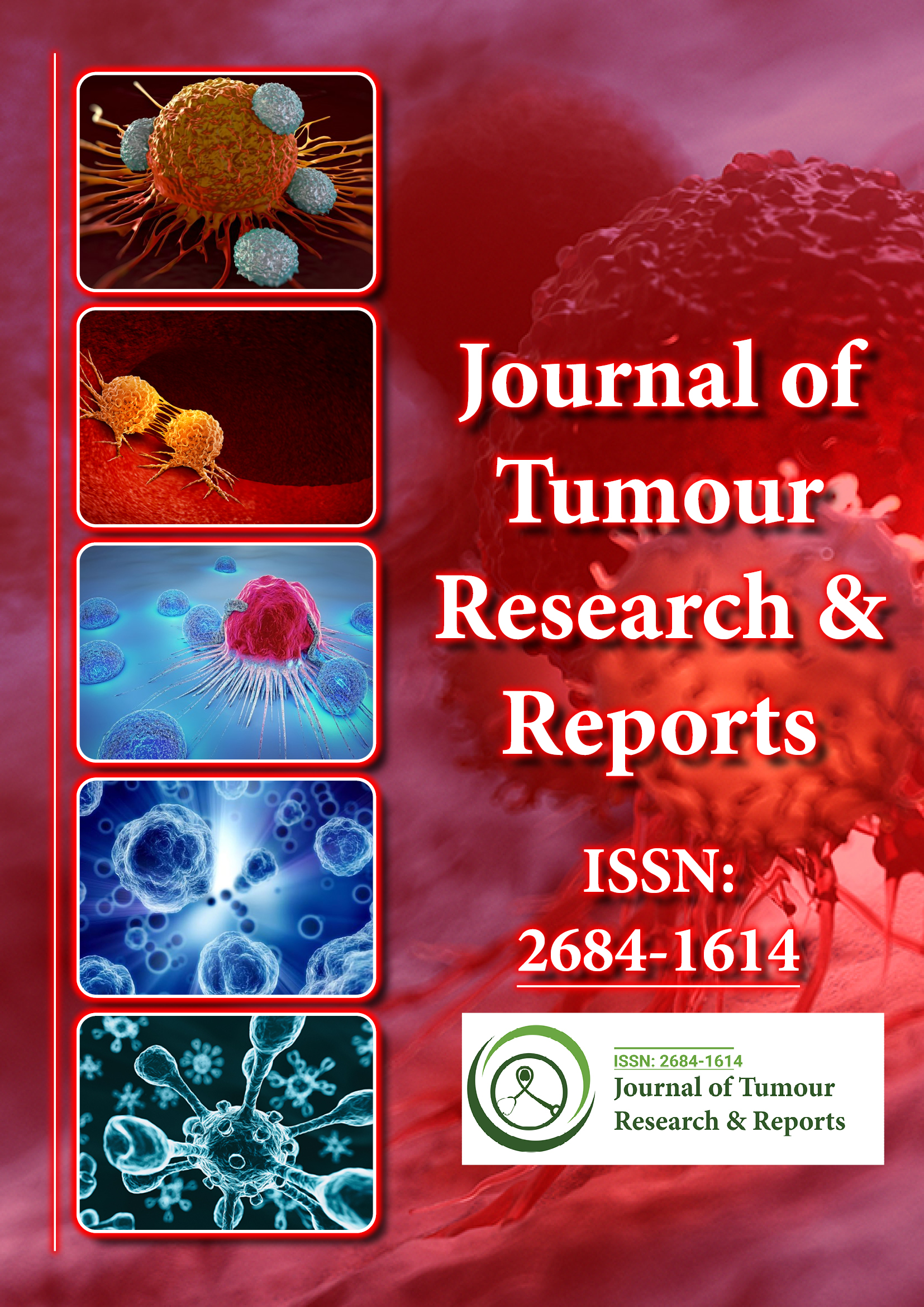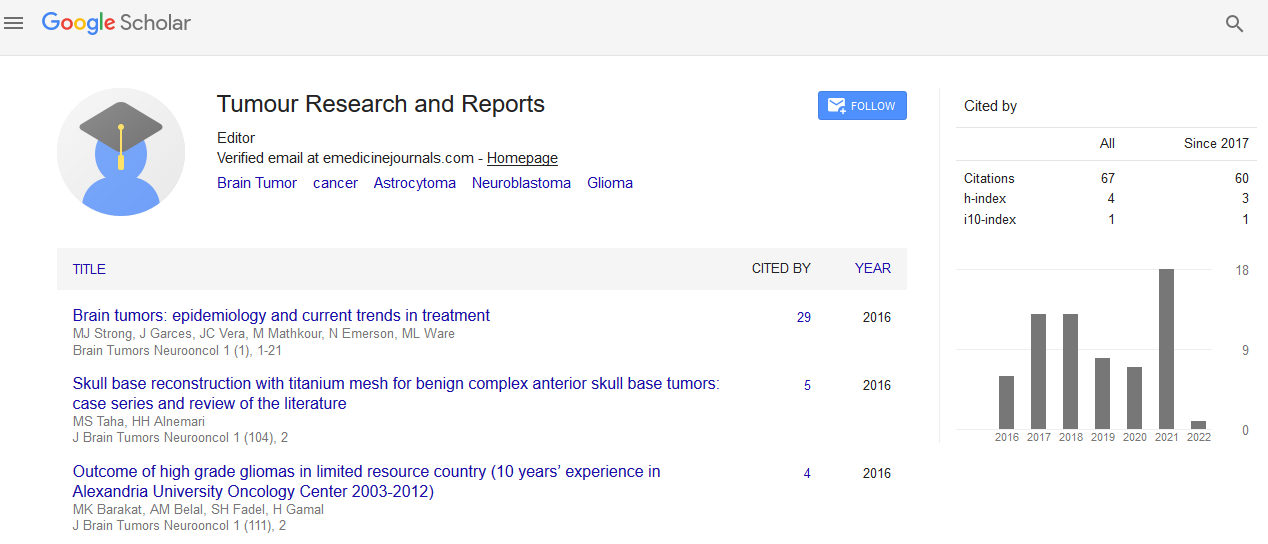Indexed In
- RefSeek
- Hamdard University
- EBSCO A-Z
- Google Scholar
Useful Links
Share This Page
Journal Flyer

Open Access Journals
- Agri and Aquaculture
- Biochemistry
- Bioinformatics & Systems Biology
- Business & Management
- Chemistry
- Clinical Sciences
- Engineering
- Food & Nutrition
- General Science
- Genetics & Molecular Biology
- Immunology & Microbiology
- Medical Sciences
- Neuroscience & Psychology
- Nursing & Health Care
- Pharmaceutical Sciences
Opinion Article - (2024) Volume 9, Issue 3
Urinary Extracellular Vesicles as a Marker of Muscle Invasiveness in Urinary Bladder Cancer
Gabrielsson Maria*Received: 30-Aug-2024, Manuscript No. JTRR-24-27823; Editor assigned: 02-Sep-2024, Pre QC No. JTRR-24-27823; Reviewed: 16-Sep-2024, QC No. JTRR-24-27823; Revised: 23-Sep-2024, Manuscript No. JTRR-24-27823; Published: 30-Sep-2024, DOI: 10.35248/2684-1614.24.9.237
Description
Urinary Bladder Cancer (UBC) is one of the most common malignancies worldwide and its incidence is rising steadily, especially in older populations. Despite advancements in diagnosis and treatment, the prognosis for UBC patients remains poor, particularly for those with Muscle-Invasive Bladder Cancer (MIBC). This aggressive form of the disease is associated with high mortality rates, primarily due to metastasis and the challenges posed by conventional treatments like cystectomy or chemotherapy. Therefore, the identification of novel biomarkers for early diagnosis, disease progression and invasiveness is critical. One promising area of research revolves around urinary Extracellular Vesicles (uEVs), which are emerging as a potential non-invasive marker for detecting muscle invasiveness in UBC.
Extracellular Vesicles (EVs) are membrane-bound particles released by various cell types into biological fluids, including urine. These vesicles play a key role in cell communication and can carry proteins, lipids, RNA and DNA that reflect the biological state of the cell from which they originated. Importantly, uEVs, which are derived from the urothelial cells lining the bladder, can be isolated from urine samples and analyzed for molecular content. Given that the urine is directly in contact with the urothelial tissue, uEVs serve as a valuable source of biomarkers that can reflect the status of the bladder’s cellular environment, making them a highly attractive target for cancer detection.
In bladder cancer, the invasion of cancer cells into the muscular layer of the bladder wall, termed muscle invasion, signifies a more advanced and aggressive disease. This stage of cancer is often associated with worse clinical outcomes, including a higher risk of metastasis and a lower survival rate. Accurate and timely identification of muscle invasiveness is essential for determining the appropriate treatment course. Currently, the gold standard for diagnosing MIBC is cystoscopy, followed by tissue biopsy. However, these procedures are invasive, expensive and uncomfortable for patients, which highlights the need for alternative, less invasive diagnostic methods.
Recent studies have shown that uEVs can potentially serve as non-invasive biomarkers for detecting muscle invasiveness in UBC. The molecular content of these vesicles, such as specific proteins, RNA and microRNA, can be indicative of tumor progression and invasiveness. For instance, elevated levels of specific protein markers, including those involved in cell signaling, apoptosis and metastasis, have been found in uEVs of patients with muscle-invasive tumors compared to those with Non-Muscle Invasive Bladder Cancer (NMIBC). Furthermore, the RNA profile within these vesicles has been shown to reflect the aggressiveness of the cancer, providing valuable insights into tumor biology.
In particular, the presence of certain microRNAs in uEVs has garnered attention as potential markers for muscle invasiveness. MicroRNAs, small non-coding RNA molecules that regulate gene expression, have been implicated in the regulation of cancer metastasis and invasiveness. Several studies have highlighted the differential expression of specific microRNAs in uEVs that are associated with MIBC. For example, miR-21 and miR-205 have been shown to be upregulated in the uEVs of muscle-invasive UBC patients. These microRNAs play roles in cell proliferation, migration and invasion, further emphasizing their relevance as markers of aggressive cancer phenotypes.
The advantages of using uEVs as biomarkers in UBC are numerous. First and foremost, the use of urine as a sample is minimally invasive and easily accessible, making it a highly attractive option for routine screening and monitoring. Unlike cystoscopy and biopsy, which require specialized equipment and trained personnel, urine collection is simple, non-invasive and can be performed in both clinical and home settings.
Conclusion
Despite the promise of uEVs in bladder cancer diagnostics, several challenges remain. Standardization of isolation methods and the need for robust validation in larger, multi-center studies are essential for the clinical implementation of uEV-based testing. Additionally, more research is needed to establish the sensitivity and specificity of these biomarkers for detecting muscle invasiveness and to explore their potential in predicting treatment outcomes.
In conclusion, urinary extracellular vesicles represent an exciting frontier in the diagnosis and management of urinary bladder cancer, particularly in assessing muscle invasiveness. As the field of liquid biopsy continues to evolve, uEVs may emerge as a powerful tool for non-invasive, accurate and personalized cancer care. However, further studies are essential to fully realize their clinical potential and integrate them into routine practice for bladder cancer management.
Citation: Maria G (2024). Urinary Extracellular Vesicles as a Marker of Muscle Invasiveness in Urinary Bladder Cancer. J Tum Res Reports. 9:237.
Copyright: © 2024 Maria G. This is an open access article distributed under the terms of the Creative Commons Attribution License, which permits unrestricted use, distribution, and reproduction in any medium, provided the original author and source are credited.

